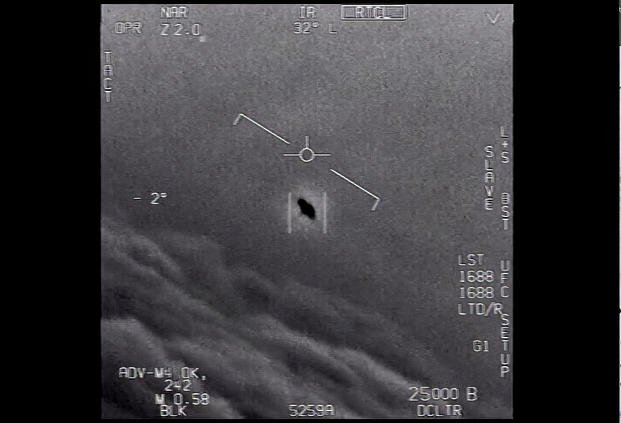Teams of Pentagon and intelligence community experts would rapidly respond to military UFO sightings and conduct field investigations under newly unveiled defense legislation set to pass Congress.
Lawmakers also want scientific and technical experts to analyze data about the objects, or what the military calls unidentified aerial phenomena, or UAP, as well as any recovered materials or medical effects, according to the text of the annual defense authorization bill released Tuesday.
The bill requires all of the findings to be collected under a new joint UAP office and delivered to Congress in annual reports and biannual briefings to defense committees, marking the most significant UFO legislation ever passed in the U.S. following high-profile encounters with unknown objects reported by the Navy.
Read Next: The National Guard Is Stuck in the Middle of Political Infighting, and It's Getting Worse
"Protecting our national security interests means knowing who and what are flying in U.S. airspace," Rep. Ruben Gallego (D-Ariz.), a sponsor of the legislation, said in a statement to Military.com. "Right now, our system of tracking and identifying UAPs is scattered throughout the Department of Defense and other departments and agencies of the federal government."
The expansive measures come just two weeks after the Pentagon announced a new group aimed at collecting and analyzing UAP incidents, sending a clear message that Congress felt the department's response was inadequate.
The Navy confirmed the authenticity of three infra-red videos showing unknown objects recorded during training exercises off San Diego in 2004 and off the East Coast in 2015. Over the past four years, fighter jet pilots and crew members have publicly said they witnessed unexplainable maneuvering, including a "Tic Tac"-shaped object with no visible means of propulsion and a flying cube inside of a sphere.
Theories on UAP range from drones or unmanned aircraft built by China or Russia to extraterrestrial or interdimensional visitors.
The new legislation to collect and analyze data on such incidents was sponsored in separate bills by Gallego and Sen. Kirsten Gillibrand (D-N.Y.), and was cosponsored by Sens. Marco Rubio (R-Fla.), Roy Blunt (R-Mo.), Martin Heinrich (D-N.M.), and Lindsey Graham (R-S.C.).
In addition to the rapid response field investigators, Congress also wants the Pentagon and intelligence community to create a science plan to understand UAP that exceed the "known state of the art in science or technology."
The bill says the information could be used to justify requests for funding in the future to "replicate any such advanced characteristics and performance" -- or reverse-engineer the UAPs.
Incidents around nuclear facilities are also noted for special attention.
Congress has never before passed legislation on UFOs, and certainly nothing near the scope of the defense bill language, said Douglas Dean Johnson, a researcher who closely follows UAP-related developments in government, and who has reported extensively on the Gallego and Gillibrand proposals.
"I have looked, and I think you will not find anything. You will find cases where Congress engaged in discourse on the issue," Johnson said.
Famous UFO initiatives in the 1940s through the 1950s such as Project Blue Book, under the Air Force, and the Condon report, sparked during a congressional committee hearing, were done without any legislation.
Decades later, the military is set to embark on a new study of flying objects, but the defense bill makes clear it won't be on the Pentagon's own terms -- and that much of the findings will be shared with Congress.
In June, Deputy Defense Secretary Kathleen Hicks ordered the Pentagon to create its UAP group on the same day the Office of the Director of National Intelligence released a long-awaited report about the military's encounters. That report found 80 incidents of unknown objects captured by multiple sensors and 18 sightings of objects that showed unusual flight characteristics.
The ODNI report concluded that UAP could pose a national security threat. "Additional rigorous analysis [sic] are necessary by multiple teams or groups of technical experts to determine the nature and validity of these data," the report said.
The Pentagon said its new monitoring and analysis group, called the Airborne Object Identification and Management Synchronization Group, or AOIMSG, would be a more organized way to collect and analyze the reports.
"We'll be as transparent as we can, but no, I don't want to leave you with the impression that there'll be sort of a regular drumbeat of, you know, of some kind of report that gets posted on a website, you know, every couple months," Pentagon spokesman John Kirby said when asked whether any UAP findings would be publicly released.
The group is run by Ronald Moultrie, the under secretary of defense for intelligence and security, and overseen by an executive council headed by Moultrie and Lt. Gen. James J. Mingus, director for operations for the Joint Staff.
-- Travis Tritten can be reached at travis.tritten@military.com. Follow him on Twitter @Travis_Tritten.
Related: Air Force Veterans Who Are UFO True Believers Return to Newly Attentive Washington















